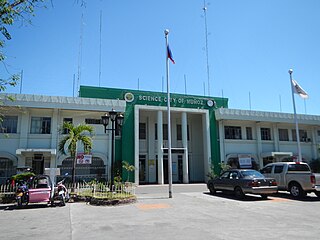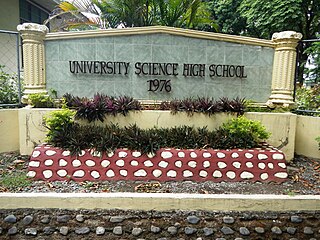
Pampanga, officially the Province of Pampanga is a province in the Central Luzon region of the Philippines. Lying on the northern shore of Manila Bay, Pampanga is bordered by Tarlac to the north, Nueva Ecija to the northeast, Bulacan to the east, the Manila Bay to the central-south, Bataan to the southwest and Zambales to the west. Its capital is the City of San Fernando. Angeles City is the largest LGU but while geographically within Pampanga, it is classified as a first-class, highly urbanized city and has been governed independently of the province since it received its charter in 1964.

Nueva Ecija, officially the Province of Nueva Ecija is a landlocked province in the Philippines located in the Central Luzon region. Its capital is the city of Palayan, while Cabanatuan City, its former capital, is the largest LGU. Nueva Ecija borders, from the south clockwise, Bulacan, Pampanga, Tarlac, Pangasinan, Nueva Vizcaya and Aurora. The province is nationally known as the Rice Granary of the Philippines, producing the largest rice yield in the country.

Oriental Mindoro is a province in the Philippines located on the island of Mindoro under Mimaropa region in Luzon, about 140 kilometres (87 mi) southwest of Manila. The province is bordered by the Verde Island Passage and the rest of Batangas to the north, by Marinduque, Maestre de Campo Island, Tablas Strait and the rest of Romblon to the east, by Semirara and the rest of Caluya Islands, Antique to the south, and by Occidental Mindoro to the west. Calapan, the only city in the island, is the provincial capital.

Nueva Vizcaya, officially the Province of Nueva Vizcaya is a landlocked province in the Philippines located in the Cagayan Valley region in Luzon. Its capital is Bayombong. It is bordered by Benguet to the west, Ifugao to the north, Isabela to the northeast, Quirino to the east, Aurora to the southeast, Nueva Ecija to the south, and Pangasinan to the southwest. Quirino province was created from Nueva Vizcaya in 1966.

Central Luzon, designated as Region III, is an administrative region in the Philippines, primarily serving to organize the 7 provinces of the vast central plains of the island of Luzon, for administrative convenience. The region contains the largest plain in the country and produces most of the country's rice supply, earning itself the nickname "Rice Granary of the Philippines". Its provinces are: Aurora, Bataan, Bulacan, Nueva Ecija, Pampanga, Tarlac and Zambales.

Muñoz, officially the Science City of Muñoz, is a 4th class component city in the province of Nueva Ecija, Philippines. According to the 2015 census, it has a population of 81,483 people.

Philippine Rice Research Institute (PhilRice) is a government corporate entity attached to the Department of Agriculture created through Executive Order 1061 on 5 November 1985 to help develop high-yielding and cost-reducing technologies for farmers.

Central Luzon State University is a state university on a 658-hectare campus in Muñoz, Nueva Ecija, Philippines. It is the lead agency of the Muñoz Science Community and the seat of the Regional Research and Development Center in Central Luzon. To date, CLSU is one of the premiere institutions for agriculture in the Philippines and in Southeast Asia known for its research in aquaculture, ruminants, crops, orchard, and water management. It has also been placed between the sixth and the twenty-first spot for the most academically-excellent university in the country for various years, surpassing most schools in Metro Manila. It has been placed in the 100 most significant schools in Asia multiple times as well.

Central Luzon State University Science High School, often shortened to University Science High School or USHS, is a science high school located inside the campus of Central Luzon State University (CLSU), in Muñoz, Nueva Ecija, Philippines. USHS is not included in the Philippine Science High School System and is under the College of Education of Central Luzon State University.
The State Colleges and Universities Athletic Association (SCUAA) is an association of 93 institutions, conferences, organizations, and individuals that organizes the athletic programs of different state colleges and universities in the Philippines. SCUAA is one of the inter-collegiate sports associations in the Philippines, the union of seven major state colleges and universities in Metro Manila.
Guijo is a species of plant in the family Dipterocarpaceae. It is a tree found in Cambodia, Laos, Vietnam, Sumatra, Peninsular Malaysia, Borneo and the Philippines. The name guijo is a Philippine Spanish word derived from the Tagalog gihò. This is also sometimes known as red balan or red balau sharing its name with Shorea balangeran. Other local names include yamban-yamban in Zambales and taralai in Tarlac.

The following outline is provided as an overview of and topical guide to the Philippines:

The Philippine Carabao Center an attached agency of the Department of Agriculture, was established at Science City of Muñoz in Nueva Ecija province in 1992 to breed and cross carabao based on high-yield Murrah buffalo in the Philippines as a multi-purpose animal that can be raised for milk, meat, hide, and draft.

United Architects of the Philippines Student Auxiliary (UAPSA) is the student organization of the United Architects of the Philippines that is composed of 94 member schools and has more than 16,000 members.
The Philippine Cyberservices Corridor is a plan that is being pursued by the government of the Philippines to create interconnected centers of technology-related services, that are spread out all over the country. Services include business process outsourcing, medical transcription, outsourcing of animation, and the like. It is part of the ten-point agenda of President Gloria Macapagal Arroyo and is one of the five "super-regions" outlined in her 2006 State of the Nation Address.












